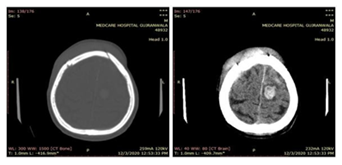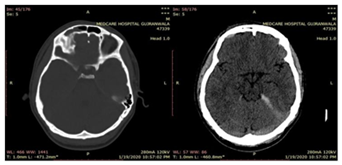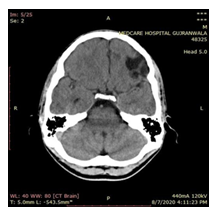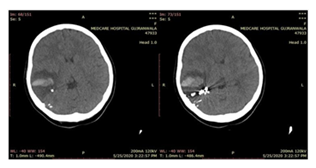Traumatic Brain Injury And Its Findings On Computed Tomography; A Tertiary Care Hospital Experience
Article Information
Dr. Mst. Maksuda Khatun1, Dr. Mohammad Shahin Akter2, Dr. Salma Shahnawaz Parvin3, Dr. Md. Towrit Reza4
1Assistant Professor, Department of Radiology and Imaging, Bangabandhu Sheikh Mujib Medical College (BSMMC), Faridpur, Bangladesh, mail: shahinjodder75@gmail.com, orcid id: 0000-0001-6092-6946
2Assistant Professor, Department of Orthopedics, Bangabandhu Sheikh Mujib Medical College (BSMMC), Faridpur, Bangladesh, mail: shahinjodder75@gmail.com, orcid id: 0000-0001-6092-6946
3Assistant Professor, Department of Radiology and Imaging, Bangabandhu Sheikh Mujib Medical College (BSMMC), Faridpur, Bangladesh, mail: shahinjodder75@gmail.com, orcid id: 0000-0001-6092-6946
4Assistant Professor, Department of Radiology and Imaging, Bangabandhu Sheikh Mujib Medical College (BSMMC), Faridpur, Bangladesh, mail: shahinjodder75@gmail.com, orcid id: 0000-0001-6092-6946
*Corresponding Author: Mst. Maksuda Khatun. Assistant Professor, Department of Radiology and Imaging, Bangabandhu Sheikh Mujib Medical College (BSMMC), Faridpur, Bangladesh
Received: 09 January 2023; Accepted: 19 January 2023; Published: 19 May 2023
Citation: Dr. Mst. Maksuda Khatun, Dr. Mohammad Shahin Akter, Dr. Salma Shahnawaz Parvin, Dr. Md. Towrit Reza. Traumatic Brain Injury And Its Findings On Computed Tomography; A Tertiary Care Hospital Experience. Journal of Radiology and Clinical Imaging. 6 (2023): 123-126.
View / Download Pdf Share at FacebookAbstract
Introduction: Traumatic brain injury (TBI), a form of acquired brain injury, occurs when a sudden trauma causes damage to the brain. TBI can result when the head suddenly and violently hits an object, or when an object pierces the skull and enters brain tissue. It remains the most common cause of death following trauma, with particularly high mortality and morbidity in low and middle-income countries (LMIC) like Bangladesh. Aim of the study: The aim of the study was to evaluate the frequency of traumatic brain injury (TBI) on computed tomography in Bangabandhu Sheikh Mujib Medical College (BSMMC), Faridpur, Bangladesh.
Methods: It is a retrospective cross-sectional study, a total of 147 patients had head injuries who were admitted to the Department of Radiology and Imaging from January 2021 to December 2021 in Bangabandhu Sheikh Mujib Medical College (BSMMC), Faridpur, Bangladesh. Patients included in this study were those who met the inclusion criteria. Data was collected from emergency departments with consent.
Result: A total of 147 patients were enrolled and analyzed in this retrospective cross-sectional study. In this study, most of the 55(37.41%) patients were from the age group 1-14 years and only 12(8.16%) patients were aged above 65 years. According to the CT scan finding, 82% of patients had a scalp hematoma, 65(44.22%) patients had normal pain, almost 30% of patients had skull fractures and only 4% of patients had inflammatory changes. In this study, 94(63.95%) patients fell from height and 53(36.05%) patients had an accidental case.
Conclusion: In conclusion, the prevalence of percentage of non-hemorrhage contusions and extradural hematoma have almost an equivalent frequency. Males have a higher rate of intracranial hemorrhage than females. Patients who have been in road traffic accidents \have a higher risk of developing a scalp hematoma than those who have had other types of traumatic injuries.
Keywords
Traumatic Brain and Computed Tomography
Traumatic Brain articles, Computed Tomography articles
Traumatic Brain articles Traumatic Brain Research articles Traumatic Brain review articles Traumatic Brain PubMed articles Traumatic Brain PubMed Central articles Traumatic Brain 2023 articles Traumatic Brain 2024 articles Traumatic Brain Scopus articles Traumatic Brain impact factor journals Traumatic Brain Scopus journals Traumatic Brain PubMed journals Traumatic Brain medical journals Traumatic Brain free journals Traumatic Brain best journals Traumatic Brain top journals Traumatic Brain free medical journals Traumatic Brain famous journals Traumatic Brain Google Scholar indexed journals Computed Tomography articles Computed Tomography Research articles Computed Tomography review articles Computed Tomography PubMed articles Computed Tomography PubMed Central articles Computed Tomography 2023 articles Computed Tomography 2024 articles Computed Tomography Scopus articles Computed Tomography impact factor journals Computed Tomography Scopus journals Computed Tomography PubMed journals Computed Tomography medical journals Computed Tomography free journals Computed Tomography best journals Computed Tomography top journals Computed Tomography free medical journals Computed Tomography famous journals Computed Tomography Google Scholar indexed journals Traumatic brain injury articles Traumatic brain injury Research articles Traumatic brain injury review articles Traumatic brain injury PubMed articles Traumatic brain injury PubMed Central articles Traumatic brain injury 2023 articles Traumatic brain injury 2024 articles Traumatic brain injury Scopus articles Traumatic brain injury impact factor journals Traumatic brain injury Scopus journals Traumatic brain injury PubMed journals Traumatic brain injury medical journals Traumatic brain injury free journals Traumatic brain injury best journals Traumatic brain injury top journals Traumatic brain injury free medical journals Traumatic brain injury famous journals Traumatic brain injury Google Scholar indexed journals low and middle-income countries articles low and middle-income countries Research articles low and middle-income countries review articles low and middle-income countries PubMed articles low and middle-income countries PubMed Central articles low and middle-income countries 2023 articles low and middle-income countries 2024 articles low and middle-income countries Scopus articles low and middle-income countries impact factor journals low and middle-income countries Scopus journals low and middle-income countries PubMed journals low and middle-income countries medical journals low and middle-income countries free journals low and middle-income countries best journals low and middle-income countries top journals low and middle-income countries free medical journals low and middle-income countries famous journals low and middle-income countries Google Scholar indexed journals scalp hematoma articles scalp hematoma Research articles scalp hematoma review articles scalp hematoma PubMed articles scalp hematoma PubMed Central articles scalp hematoma 2023 articles scalp hematoma 2024 articles scalp hematoma Scopus articles scalp hematoma impact factor journals scalp hematoma Scopus journals scalp hematoma PubMed journals scalp hematoma medical journals scalp hematoma free journals scalp hematoma best journals scalp hematoma top journals scalp hematoma free medical journals scalp hematoma famous journals scalp hematoma Google Scholar indexed journals traumatic injury articles traumatic injury Research articles traumatic injury review articles traumatic injury PubMed articles traumatic injury PubMed Central articles traumatic injury 2023 articles traumatic injury 2024 articles traumatic injury Scopus articles traumatic injury impact factor journals traumatic injury Scopus journals traumatic injury PubMed journals traumatic injury medical journals traumatic injury free journals traumatic injury best journals traumatic injury top journals traumatic injury free medical journals traumatic injury famous journals traumatic injury Google Scholar indexed journals RTA articles RTA Research articles RTA review articles RTA PubMed articles RTA PubMed Central articles RTA 2023 articles RTA 2024 articles RTA Scopus articles RTA impact factor journals RTA Scopus journals RTA PubMed journals RTA medical journals RTA free journals RTA best journals RTA top journals RTA free medical journals RTA famous journals RTA Google Scholar indexed journals hematomas articles hematomas Research articles hematomas review articles hematomas PubMed articles hematomas PubMed Central articles hematomas 2023 articles hematomas 2024 articles hematomas Scopus articles hematomas impact factor journals hematomas Scopus journals hematomas PubMed journals hematomas medical journals hematomas free journals hematomas best journals hematomas top journals hematomas free medical journals hematomas famous journals hematomas Google Scholar indexed journals GCS articles GCS Research articles GCS review articles GCS PubMed articles GCS PubMed Central articles GCS 2023 articles GCS 2024 articles GCS Scopus articles GCS impact factor journals GCS Scopus journals GCS PubMed journals GCS medical journals GCS free journals GCS best journals GCS top journals GCS free medical journals GCS famous journals GCS Google Scholar indexed journals non-hemorrhage contusions articles non-hemorrhage contusions Research articles non-hemorrhage contusions review articles non-hemorrhage contusions PubMed articles non-hemorrhage contusions PubMed Central articles non-hemorrhage contusions 2023 articles non-hemorrhage contusions 2024 articles non-hemorrhage contusions Scopus articles non-hemorrhage contusions impact factor journals non-hemorrhage contusions Scopus journals non-hemorrhage contusions PubMed journals non-hemorrhage contusions medical journals non-hemorrhage contusions free journals non-hemorrhage contusions best journals non-hemorrhage contusions top journals non-hemorrhage contusions free medical journals non-hemorrhage contusions famous journals non-hemorrhage contusions Google Scholar indexed journals
Article Details
1. Introduction
Traumatic brain injury (TBI), a form of acquired brain injury, occurs when a sudden trauma causes damage to the brain. TBI can result when the head suddenly and violently hits an object, or when an object pierces the skull and enters brain tissue. It remains the most common cause of death following trauma, with particularly high mortality and morbidity in low and middle-income countries (LMIC) like Bangladesh [1]. Head injury according to WHO will surpass many diseases as the major cause of death and disability by the year 2020 [2]. High illness and death rates in low and middle-income countries are present to traumatic head injuries [3]. Traumatic brain injury can be defined as changed brain function, confusion, coma and change in consciousness or neuromotor deficit [4]. TBI is very much related to traumatic head injuries which occur mostly due to RTA in young people and fall history in children [5, 6]. Male are highly involved because they are mostly outdoors like driving, vehicles, and working outdoors [6-10]. Previous study found intra-cerebral hematoma (46.33%), skull fracture (62.04%), subdural hematoma (19.37%), brain swelling and edema (63.35%), midline shift (24.34%), subarachnoid hematoma (28.79%), epidural hematoma (30.36%) and neurocranium (12.04%) [11]. In Bangladesh, the annual incidence of head injury found was 814.8/1, 00,000 people with mortality rate of 23.39/100,000 population [12]. All types of injuries but basically death and disability mostly occur due to brain injuries [13]. Brain injuries involve contusions, intracranial injuries, skull fracture, bruising, hematomas, brain swelling, edema and hemorrhages [11, 14]. Patients with brain injuries usually involve symptoms of loss of consciousness, short-term memory loss, amnesia, behaviour change, irritability, vomiting and headache all after traumatic injuries but the post injuries include traffic accidents, slipping down, fall down injuries etc. [15-17]. CT scan examination may be important in some cases however in most cases it is challenging to achieve as for the troubles with radioactivity contact and bulk motions. In addition, if no intracranial abnormality is detected immediately after injury, irregular findings might seem several hours later [18].
2. Materials and Methods:
It is a retrospective cross-sectional study, a total of 147 patients had head injuries who were admitted to the the Department of Radiology and Imaging from January 2021 to December 2021 in Bangabandhu Sheikh Mujib Medical College (BSMMC), Faridpur, Bangladesh. Patients included in this study were those who met the inclusion criteria. Data was collected from emergency departments with consent.
2.1 Inclusion criteria
- Patient with traumatic brain injury
- RTA and history of fall with a scale of 13-15 GCS with symptoms of dizziness
- GCS with symptoms of nausea
- GCS with symptoms of headache
- Patients who had vomiting and altered state of consciousness
2.2 Exclusion criteria
- Patients who died before the stage of Computed tomography
- Arriving at the hospital 24 hours after injury and drinking alcohol.
All data were presented in a suitable table or graph according to their affinity. A description of each table and graph was given to understand them clearly. Collected information is compiled, analyzed, and edited using the software SPSS (version 24.0) (IBM) Chicago, Illinois.
3. Results
A total of 147 patients were enrolled and analyzed in this retrospective cross-sectional study. In this study, most of the 55(37.41%) patients were from the age group 1-14 years and only 12(8.16%) patients were aged above 65 years (Table 1). Table 2 shows the distribution of the study, 105(71.43%) patients were male and 42(28.57%) patients were female. According to the CT scan finding, 82% of patients had a scalp hematoma, 65(44.22%) patients had normal pain, almost 30% of patients had skull fractures and only 4% of patients had inflammatory changes (Table 3). Table 4 shows the cause of injuries, 94(63.95%) patients fell from height and 53(36.05%) patients had an accidental case. Figures 1 (H/O RTA), 2 (Vomiting), 3 (Headache) & 4 (FITS) show the patient’s CT-scan images.
|
Age range (Years) |
Frequency |
Percentage |
|
Jan-14 |
55 |
37.41 |
|
15-30 |
38 |
25.85 |
|
31-50 |
18 |
12.24 |
|
51-65 |
24 |
16.33 |
|
Above 65 |
12 |
8.16 |
|
Total |
147 |
100 |
Table 1: Age distribution of the study population.
|
Gender |
Frequency |
Percentage |
|
Male |
105 |
71.43 |
|
Female |
42 |
28.57 |
|
Total |
147 |
100.00 |
Table 2: Gender distribution of the study population.
|
Findings |
Frequency |
Percentage |
|
Extra Dural hematoma |
7 |
4.76 |
|
Non-hemorrhagic contusion |
6 |
4.08 |
|
Hemorrhagic contusion |
18 |
12.24 |
|
Scalp hematoma |
121 |
82.31 |
|
Subarachnoid hemorrhage |
12 |
8.16 |
|
Age-related cerebral atrophy |
25 |
17.01 |
|
Subdural Hematoma |
20 |
13.61 |
|
Inflammatory changes |
6 |
4.08 |
|
Normal plain CT examination of the brain |
65 |
44.22 |
|
Skull fracture |
44 |
29.93 |
Table 3: Findings seen in CT scan.
|
Cause of injury |
Frequency |
Percentage |
|
Fall from height |
94 |
63.95 |
|
Road traffic accident |
53 |
36.05 |
|
Total |
147 |
100.00 |
Table 4: Cause of injuries.

Figure 1: Male patient’s CT Brain (75 Years), H/O RTA (Google source)

Figure 2: Male patient’s H/O RTA (20 Year), Vomiting (Google source)

Figure 3: Male patient’s H/O Fall, (15 Year) Unbalance, Headache (Google source)

Figure 4: Male patient’s H/O Fall (15 Year), FITS (Google source)
4. Discussion
In our consequences, it is reliable throughout prior studies that showed head injury is common in RTA the majority dynamic time of years. A study reported that head injury during RTA was seen in 63% [19]. Whereas in another study it was reported that 59-69% of head injuries happen in adolescents [20]. Another research, it accomplished that behind head injury to affect results age is the solitary reason. The result was not as good as through the rising generation. In a recent study, the result shows that about 71.5% of injuries occur in males compared to females, which were about 28.5%, and mostly the incidence is present from age 1-14 years about 37%. From a Bangladeshi study, there are three leading causes found were transport injury 30.6% followed by falls 26.2% and violence 14.9% [12]. In our study, we found 53(36.05%) road accident injuries which is near to the previous study. CT-scan had become the one to find the changes that occur in the brain after trauma. Our research reports that most trauma occurs in men compared to women. It is concluded that extradural hematoma was about 4.5%, non-hemorrhagic contusion was 4%, age-related cerebral atrophy at 17%, inflammatory changes were seen at about 4%, and fracture in the skull was seen at about 30%. It was initially stated that head trauma sufferers were mostly men as compared to females because they have more outside exposures on roads and other activities that are outdoors compared to females seen in Bangladesh. In another research, the men were largely occupied with head injuries (86%) [19]. One study found that epidural hematomas were associated with skull fractures in approximately 91% of patients [21].
Limitations of the study:
The study was conducted in a single hospital with small sample size. So, the results may not represent the whole community
5. Conclusion and Recommendations
According to our research, the prevalence of percentage of non-hemorrhage contusions and extradural hematoma have almost an equivalent frequency. Males have a higher rate of intracranial hemorrhage than females. Patients who have been in road traffic accidents \have a higher risk of developing a scalp hematoma than those who have had other types of traumatic injuries. GCS reliability is insufficient since computed tomography is needed for diagnosis and confirmation of the patient's condition. According to our results, it is suggested that patients who have suffered a brain injury must undergo an acute non-contrast computed tomography to determine the best course of treatment. It is very helpful in unconscious patients who have allergies to contrast media. In order to determine the mode of injury, the patient's history should be thoroughly examined. A follow-up scan should be performed within 24-48 hours of the incident to identify the effects of bleeding. The GCS ranking system isn't enough for accident classification. For such patients, a CT scan is prescribed as the first line of examination
Funding:
No funding sources
Conflict of interest:
None declared.
References
- Hyder AA, Wunderlich CA, Puvanachandra P, et al. The impact of traumatic brain injuries: a global perspective. NeuroRehabilitation 22(2007): 341-353.
- Murray CJ, Lopez AD, World Health Organization. The global burden of disease: a comprehensive assessment of mortality and disability from diseases, injuries, and risk factors in 1990 and projected to 2020: summary. World Health Organization 1 (1996).
- Onwuchekwa CR, Alazigha, NS. Computed tomography pattern of traumatic head injury in Niger Delta, Nigeria: A multicenter evaluation. International journal of critical illness and injury science 7 (2017): 150.
- Paci M, Infante-Rivard C, Marcoux J. Traumatic brain injury in the workplace. Canadian journal of neurological sciences 44 (2017): 518-524.
- Hans P, Mehrotra A, Kumar P, et al. Role of Computerized Tomography as Prime Imaging Modality in the Evaluation of Traumatic Brain Injury. Int J AdvInteg Med Sci 2 (2017): 17-23.
- Hassan N, Ali M, Haq N, et al. Etiology, clinical presentation and outcome of traumatic brain injury patients presenting to a teaching hospital of Khyber Pakhtunkhwa. Journal of Postgraduate Medical Institute (Peshawar- Pakistan) 31 (2017).
- AHMAD I, RAZA MH, ABDULLAH A, et al. Intracranial CT scan Findings in the Patients of Head Injury: An Early Experience at Dera Ghazi Khan Teaching Hospital. Pakistan Journal of Neurological Surgery 24 (2020): 248-252.
- Khan M, Yaqoob U, Hassan Z, et al. Immediate Outcomes of Traumatic Brain Injury at a Tertiary Care Hospital of Pakistan-A Retrospective Study 10 (2020)
- Naheed K, Pal MI, Naeem M, et al. ANALYSIS OF DEATHS DUE TO ROAD TRAFFIC ACCIDENTS IN FAISALABAD CITY-PAKISTAN. Journal of University Medical & Dental College 10 (2019): 38-43.
- Mehta RA, Bambhaniya AB. Profile of Fatal Head Injuries in and Around Jamnagar Region. Indian Journal of Forensic Medicine and Pathology 11 (2018): 187.
- Gupta PK, Krishna A, Dwivedi AN, et al.. CT scan findings and outcomes of head injury patients: A cross sectional study. Journal of Pioneering Medical Sciences 1 (2011): 78.
- Hossain MJ, Ferdoush J, Shawon RA, et al. PW 2842 Epidemiology of traumatic head injury-nationally conducted survey findings from bangladesh. Injury Prevention 24 (2018): A195.
- El Hendawy MM, Mohammed MS, Saad AH. Surgical Management of Open Traumatic Head Injury. The Egyptian Journal of Hospital Medicine 78 (2020): 42-47.
- Ibrahim SY. Study of Traumatic Head Injuries Using Computerized Tomography Among Sudanese. International J of Biomedicine 11(2021).
- Kong MH, Jang SY, Kim JH, et al. The usefulness of brain magnetic resonance imaging with mild head injury and the negative findings of brain computed tomography. Journal of Korean Neurosurgical Society 54 (2013): 100-106.
- Polinder S, Cnossen MC, Real RG, et al. A multidimensional approach to post-concussion symptoms in mild traumatic brain injury. Frontiers in neurology 9 (2018): 1113.
- Cnossen MC, van der Naalt J, Spikman JM, et al. Prediction of persistent post-concussion symptoms after mild traumatic brain injury. Journal of neurotrauma 35 (2018): 2691-2698.
- Shiomi N, Echigo T, Hino A, et al. Criteria for CT and initial management of head injured infants: a review. Neurologia medico-chirurgica 56 (2016): 442-448
- Bharti P, Nagar AM, Umesh T. Pattern of trauma in western Uttar Pradesh. Neurology India 41(1993): 49-50.
- Reverdin A. Head injury in children. NIMS: Head injury, clinical management and research. Elizabeth Frost (ed), Geneva, Switzerland: Airsen 10 (1990):193-204.
- Phonprasert CH, Suwanwela CH, Hongsaprabhas CH, et al. Extradural hematoma: analysis of 138 cases. The Journal of trauma 20 (1980):679-683.
